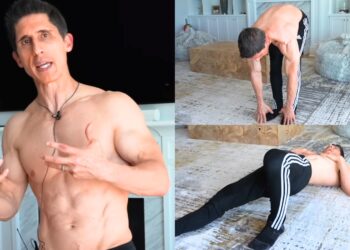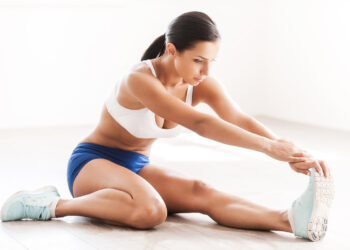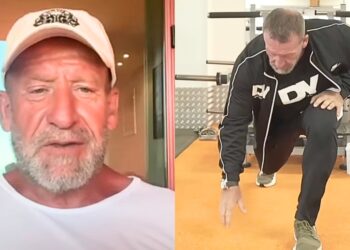A tight lower back and hips can be caused by everything from tight hips to heavy lifting, overuse, injury, or even poor sitting posture. Stretching is one of the most crucial things we can do to help keep our muscles loose and healthy and in this guide, we’ll show you the lying crossover stretch for a sore and tight lower back.
The lying crossover stretch is simple but it does require a little bit of mobility in the joints and back flexibility. We’ve also included a stability ball variation as a progression to the full movement.
How To Do The Lying Crossover Stretch
There’s not much to the lying crossover stretch but we’ve explained how to do it properly with a video example below.
Note: We recommend doing a few minutes of light activity (e.g., warmup, exercise bike, etc) to warmup the muscles involved in this stretch to make them more pliable and less prone to injury.
Exercise instructions:
- Lie on your back and relax your arms down by your sides.
- Bend the left leg and place your foot flat on the floor.
- Bring your arms out wide so that your body resembles the letter “T” or a cross.
- Drop the left leg down over your right leg and turn your head to the left. Try to keep your upper back flat on the floor. Allow your leg relax as you feel the stretch in your lower back.
- Hold this position for 20-30 seconds then repeat on the opposite side.
Here’s a video demonstration of the lying crossover stretch.
Pro tip: Gently pull the knee toward the floor to increase the stretch in your lower back.
Benefits of Lying Crossover Stretch
Stretching should be a non-negotiable activity for the reasons mentioned below.
Level Up Your Fitness: Join our 💪 strong community in Fitness Volt Newsletter. Get daily inspiration, expert-backed workouts, nutrition tips, the latest in strength sports, and the support you need to reach your goals. Subscribe for free!
Maintain and increase range of motion
Tight muscles affect range of motion in the joints as the two go hand in hand. That’s because when a muscle gets used to being in a shortened position, the joints adapt and do not have as much movement. Consequently, performing sudden and intense movements with tight muscles can cause an injury. Stretching can help to reduce the force and impact on a muscle.
If you’re an active person then skipping stretching should not be an option.
Get relief
As we noted to start off this article, lack of movement, overuse and injuries will affect your muscles, and stretching is one way to loosen up tight fibers that can cause pain and discomfort.
Help your posture
Good posture is important for so many reasons including your spine health, appearance, etc. Everything from your back to hips, and glutes are responsible for supporting a healthy upright posture and so another reason to be stretching on a daily basis.
Feel better every day
A 2013 study found that a stretching program was moderately effective for “reducing levels of anxiety, bodily pain and exhaustion, raising levels of vitality, mental health, general health and flexibility (1).
But do you ever notice the overall relief you get after stretching first thing in the morning? The body needs to be relieved of its built up tension due to our lifestyles.
Variations
Here are some variations of the lying crossover stretch from easier to more challenging:
1. Crossover stretch with stability ball
If you lack decent flexibility or the lying crossover stretch is otherwise uncomfortable for you, then we recommend using a Swiss or exercise ball. What this does is it allows you to use a shorter range of motion while supporting the weight of your legs.
2. Straight leg crossover stretch
While the version explained in this guide is done with the knee bent, you can also keep your leg fully extended. You’ll have to determine which variation you prefer but it’s good to try both to see if one feels better.
3. Pretzel stretch
One of our favorite variations and probably one you’ve done before, the pretzel stretch targets the lower back, glutes, and obliques. It’s a great option if you don’t want to lie on your back which has its advantages.
Level Up Your Fitness: Join our 💪 strong community in Fitness Volt Newsletter. Get daily inspiration, expert-backed workouts, nutrition tips, the latest in strength sports, and the support you need to reach your goals. Subscribe for free!
4. Crossbody version
To emphasize the stretch in your glutes, you can pull the knee in a diagonal direction.
Alternatives
The following are a few alternative options for stretching your lower back:
1. Cat-cow pose
A popular yoga style stretch, the cat-cow pose is an ideal warmup and stretch mobility exercise for the lower back. You can find exercise instructions for the cat-cow pose in our article on the 8 Best Lower Back Stretches for A More Mobile Spine.
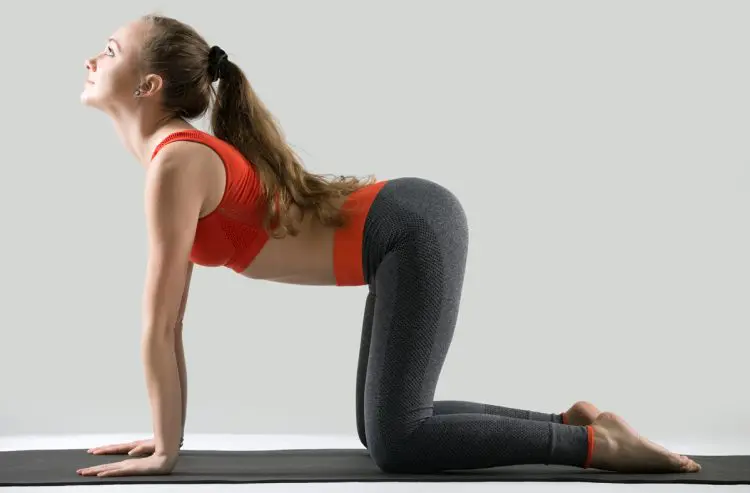
2. Knee to chest stretch
Another very simple lower back stretch is the knee to chest. It may actually be a more comfortable variation for a lot of people because you don’t have to twist your body to do it. Most people will be able to perform this stretch with no problem and awesome the benefits.
3. Dead hang
If you have the grip strength to hang from a pull-up bar, then you should absolutely be doing a dang hang every single morning to decompress your spine and stretch your lower back after a night of zzz’s.
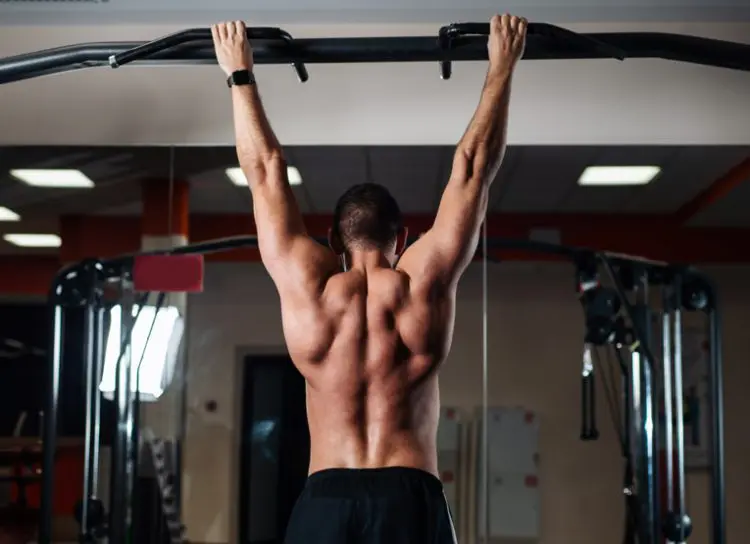
Check out our full dead hang guide here.
How To Incorporate the Lying Crossover Stretch
The lying crossover stretch is a versatile technique that can be incorporated a few different ways because stretching is something that you can do anytime of the day.
Upon waking
Stretching first thing in the morning/upon waking is one of the best things you can do for the long term health of your body. It keeps your muscle long, loose and healthy which is going to help prevent injuries and lack of movement in the joints.
Ideally, you’ll do a few minutes of walking to get your muscles warmed up before stretching.
After a workout
Stretching after physical activity is ideal because movement gets blood into the muscles which makes them more pliable and elastic.
“When everything is cold, the fibers aren’t prepared and may be damaged. If you exercise first, you’ll get blood flow to the area, and that makes the tissue more pliable and amenable to change,” explained David Nolan, a physical therapist at Harvard-affiliated Massachusetts General Hospital.
According to research, you’re probably better off stretching warm muscle fibers.
Sets and Reps
As with every exercise, your experience level, goals, and time will ultimately determine how you train or stretch a muscle group. However, some is better than none. If you can fit it in, we recommend 2-3 sets of the lying crossover stretch held for 20-30 seconds.
You may need more or less but this will again depend on the above mentioned factors. The important thing is to just start stretching with proper technique.
Muscles Involved
The lying crossover technique is a great total body exercise it stretches the hips, glutes, lower back and obliques.
- Lower back/erector spinae – These are the muscles along either side of the spinal column that span the entire back that include iliocostalis, longissimus, and spinalis. But there are nine erector spinae muscles. These muscles primarily extend (bend over backwards) and laterally flex (flex the torso down toward the floor on the left and right sides) the back.
- Obliques – A part of your core section of muscles alongside the abdominals, obliques are involved during rotation, lateral flexion, and stability of the trunk. The obliques get a nice stretch during this exercise due to the rotation.
- Glutes – Our butt is made up of different muscles including the gluteus maximus (largest), medius and minimus (smallest) that act on the hips during movements such as extension, adduction, abduction, and external and internal rotation of the thigh. You can accentuate the stretch in your glutes by pulling down on the leg during the lying crossover stretch.
- Iliopsoas – The iliopsoas is the most prominent of the hip flexor muscles that consists of major and minor psoas muscles and the iliacus muscle. Without proper functioning of this muscle we wouldn’t be able to pull our thighs up past parallel in relation to the ground.
- Pectineous – One of the adductors, pectineous is a hip flexor and medial rotator.
- Sartorius – The sartorius is the longest muscle in the body crossing both the knee and hip joints which means it has function at both ends such as knee and thigh flexion and external rotation of the hips.
- Tensor Fasciae Latae – The tensor fascia latae (TFL) belongs to the glute family. Along with the gluteus medius and gluteus minimus, the TFL internally rotates and abducts the hip.
Bottom Line
While there are many stretching exercises for the lower back, the lying crossover stretch is one you probably need in your arsenal. It’s very simple and easy so long as you have decent range of motion in your joints and muscles. But we also like the variations and alternatives of this exercise for different experience levels or a more advanced stretch in the muscle.


